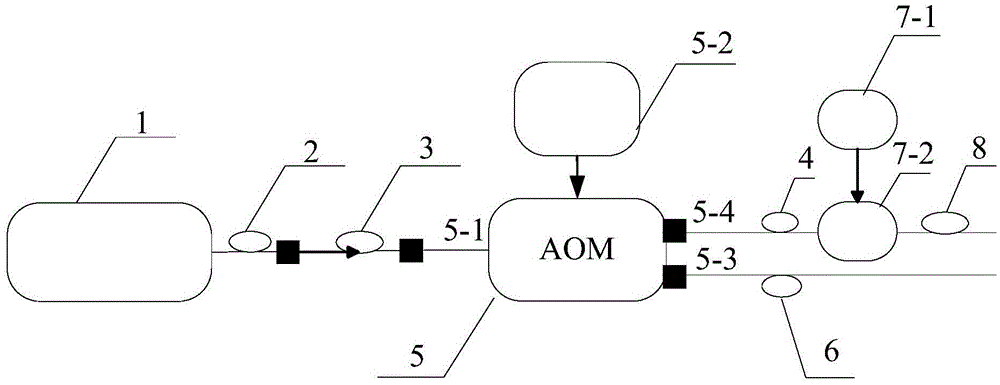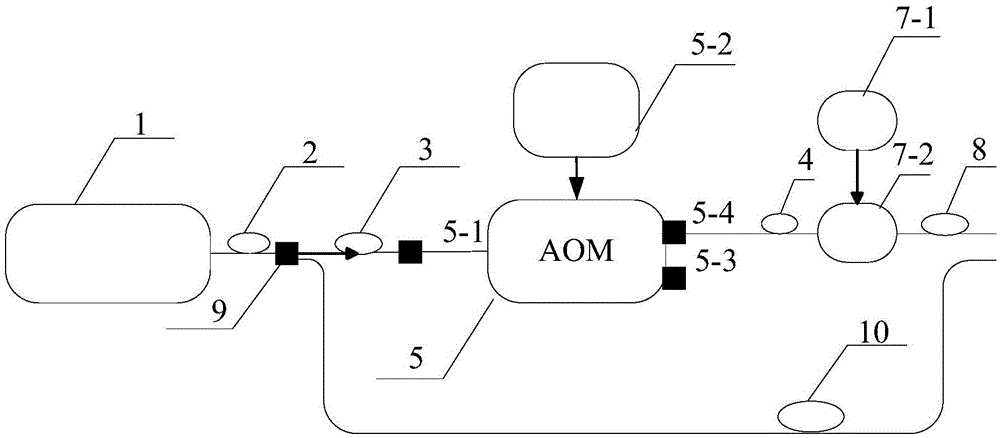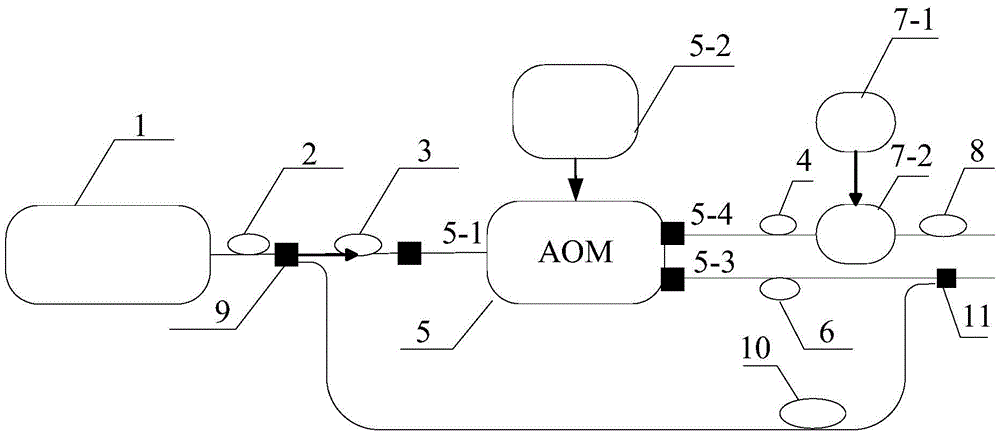A Coherent Wind Lidar Pulse Signal Transmitting System
A laser radar and laser signal technology, applied in radio wave measurement systems, measurement devices, and use of re-radiation, etc., can solve the problems of single adjustment method and high requirements for lasers, improve transmission quality, wide modulation range, and avoid polarization state. changing effect
- Summary
- Abstract
- Description
- Claims
- Application Information
AI Technical Summary
Problems solved by technology
Method used
Image
Examples
Embodiment approach 1
[0027] Embodiment 1: This embodiment is as follows figure 1 As shown, the fiber laser 1 emits a 2 μm continuous laser signal, and outputs it through the first single-mode polarization-maintaining fiber 2, and the 2 μm laser signal enters the fiber-optic online polarizer 3 to generate linearly polarized laser light, and then passes the 2 μm acousto-optic frequency shift The input port 5-1 of the device 5 enters the 2 μm acousto-optic frequency shifter 5;
[0028] Adjust the voltage of the frequency modulation port 5-2 to 5.2V to achieve the maximum diffraction efficiency, and output two laser signals;
[0029] The laser beam output by the first-order diffraction port 5-4 is output through the second single-mode polarization-maintaining optical fiber 4, enters the chopper 7-2 through the input port of the chopper 7-2, and the external drive signal passes through the external drive signal interface 7- 1 into the chopper 7-2, by adjusting the period and duty ratio of the external...
Embodiment approach 2
[0030] Implementation mode two: this implementation mode is as follows figure 2 As shown, the fiber laser 1 emits a 2 μm continuous laser signal, and outputs it through the first single-mode polarization-maintaining fiber 2, and divides it into the first laser branch signal and the second laser branch signal through the fiber beam splitter 9, and the first laser branch signal The signal enters the optical fiber online polarizer 3 to generate linearly polarized laser light, and then enters the 2 μm acousto-optic frequency shifter 5 through the input port 5-1 of the 2 μm acousto-optic frequency shifter 5;
[0031] Adjust the voltage of the frequency modulation port 5-2 to 5.2V to achieve the maximum diffraction efficiency, and output two laser signals;
[0032] The laser beam output by the first-order diffraction port 5-4 is output through the second single-mode polarization-maintaining optical fiber 4, enters the chopper 7-2 through the input port of the chopper 7-2, and the e...
Embodiment approach 3
[0034] Implementation Mode Three: This implementation mode is as follows image 3 As shown, the fiber laser 1 emits a 2 μm continuous laser signal, and outputs it through the first single-mode polarization-maintaining fiber 2, and divides it into the first laser branch signal and the second laser branch signal through the fiber beam splitter 9, and the first laser branch signal The signal enters the optical fiber online polarizer 3 to generate linearly polarized laser light, and then enters the 2 μm acousto-optic frequency shifter 5 through the input port 5-1 of the 2 μm acousto-optic frequency shifter 5;
[0035] Adjust the voltage of the frequency modulation port 5-2 to 5.2V to achieve the maximum diffraction efficiency, and output two laser signals;
[0036] The laser beam output by the first-order diffraction port 5-4 is output through the second single-mode polarization-maintaining optical fiber 4, enters the chopper 7-2 through the input port of the chopper 7-2, and the ...
PUM
 Login to View More
Login to View More Abstract
Description
Claims
Application Information
 Login to View More
Login to View More - R&D
- Intellectual Property
- Life Sciences
- Materials
- Tech Scout
- Unparalleled Data Quality
- Higher Quality Content
- 60% Fewer Hallucinations
Browse by: Latest US Patents, China's latest patents, Technical Efficacy Thesaurus, Application Domain, Technology Topic, Popular Technical Reports.
© 2025 PatSnap. All rights reserved.Legal|Privacy policy|Modern Slavery Act Transparency Statement|Sitemap|About US| Contact US: help@patsnap.com



